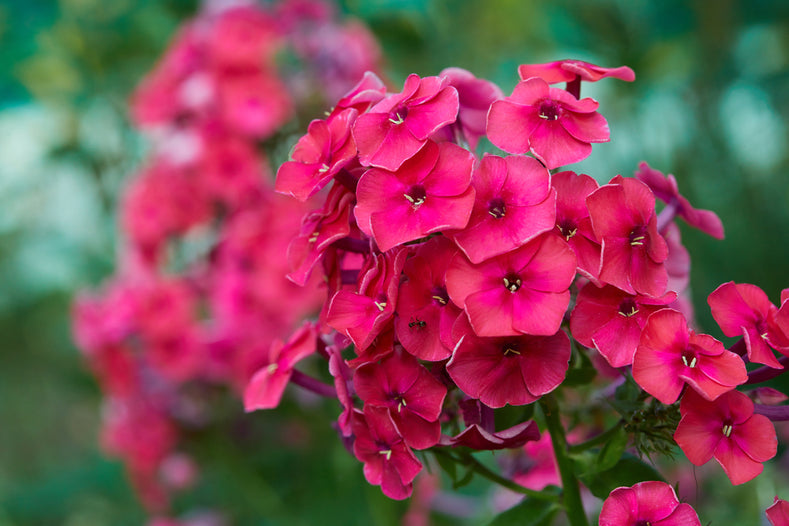Phlox, known for their profusion of small, often scented flowers in summer, come in various forms from tall perennials to creeping or alpine varieties. Some even grow as annuals for bedding purposes.
One popular type is Phlox paniculata, commonly called garden phlox or border phlox. In the wild, it can reach heights of nearly 2 metres and display pink flowers. Through years of breeding, shorter and more colourful cultivars have been developed, ranging in shades from blue and purple to pink, magenta, red, and white. These garden-worthy varieties not only offer fragrance and long flowering periods but also attract bees and other pollinating insects.
Phlox are hardy and easy to grow, making them valuable members of herbaceous borders and cottage gardens. Their sturdy stems usually eliminate the need for staking, and they tend to be resistant to pests and diseases, providing years of beauty in the garden. Combining well with other perennials like delphiniums and red hot pokers, they can also be paired with ornamental grasses for a more modern look. Phlox also makes excellent cut flowers.
To successfully grow phlox, choose a sunny spot with moist, well-drained soil. In hot, dry weather, make sure to keep them well-watered, as they are sensitive to drought. While they generally require little care, deadheading promptly after flowering can encourage more blooms later in the season. Dividing the plants every few years is beneficial for their health and continued flowering. For taller varieties, place them in the back or middle of a border, while shorter ones are best suited for the front.
When planting phlox in spring, ensure the soil is warm and moist, as they don't thrive in dry, sandy soils. Adding organic matter like garden compost or well-rotted manure before planting and mulching afterwards will improve the soil conditions. Phlox tends to form large clumps over time, so dividing them every three or four years in early spring will maintain their vitality and prevent overcrowding. Signs that division is necessary include reduced flower production and a sparse centre
How to Plant Phlox:
- Choose the Right Location: Select a suitable location for planting your Phlox bare roots. They prefer full sun to partial shade, so find a spot that receives at least 4-6 hours of sunlight each day. Ensure the soil is well-drained to prevent waterlogging, as Phlox do not thrive in waterlogged conditions.
- Prepare the Soil: Before planting, prepare the soil in the chosen area. Remove any weeds, rocks, or debris from the planting site. You can also amend the soil by adding compost or well-rotted manure to improve its fertility and drainage. Work the soil to a depth of about 30 cm to loosen it up.
- Soak the Bare Roots: It’s a good idea to soak them in water for about an hour before planting. This will rehydrate the roots and prepare them for planting.
- Dig the Planting Hole: Use a shovel to dig a hole in the prepared soil that is large enough to accommodate the roots of the Phlox plant. The hole should be deep enough so that the top of the root ball is level with the surrounding soil.
- Place the Plant in the Hole: Gently place the bare root Phlox plant into the hole you dug, ensuring that the roots are spread out and not bunched up. Position the plant so that the crown (where the roots meet the stem) is just at ground level.
- Backfill the Hole: Fill the hole with soil, carefully tamping it down around the roots to eliminate any air pockets. Be gentle to avoid damaging the delicate roots. Once the hole is filled, the plant should be stable and upright.
- Water Thoroughly: After planting, give the Phlox a thorough watering to help settle the soil and encourage root establishment. Water the plant until the soil is evenly moist but not waterlogged.
- Mulch (Optional): Applying a layer of organic mulch around the base of the plant can help retain moisture, suppress weeds, and regulate soil temperature. However, be sure to leave a small gap around the stem to prevent rot.
- Keep the Soil Moist: During the initial weeks after planting, make sure to keep the soil consistently moist but not waterlogged. This will help the plant establish its roots and promote healthy growth.
- Monitor and Care: Regularly monitor your newly planted Phlox for any signs of growth and adjust watering accordingly. Once established, Phlox are generally low-maintenance, but you may need to water during dry spells and provide some support if they are tall varieties.
By following these steps, you can plant bare root Phlox successfully and enjoy their beautiful flowers in your garden!


